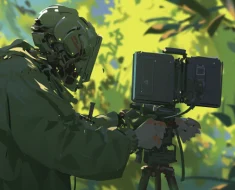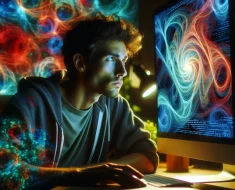You’ve probably heard about AI, or artificial intelligence, but how much do you really know about it? As we celebrate AI Appreciation Day, let’s take a fun journey through AI in pop culture and see how it stacks up against real-life tech.
Lights, Camera, AI-ction!
Remember when you first saw a robot on the big screen? Maybe it was the Terminator’s glowing red eye or C-3PO’s golden shine. Hollywood’s been fascinated with AI for decades, giving us a wild mix of helpful sidekicks and terrifying overlords.
AI Stars on the Silver Screen
On this AI Appreciation Day, let’s appreciate some of the most memorable AI characters in cinema. These digital stars have shaped our perceptions of AI, for better or worse:


1. HAL 9000 from “2001: A Space Odyssey” (1968): This red-eyed AI remains one of the most chilling portrayals of artificial intelligence gone wrong.


2. C-3PO and R2-D2 from “Star Wars” (1977): These lovable droids showed us that AI could be helpful, loyal, and even humorous.


3. The Terminator from “The Terminator” series (1984): Arnold Schwarzenegger’s iconic role brought the concept of AI to action movie fans worldwide.


4. WALL-E from “WALL-E” (2008): This adorable waste-collecting robot proved that AI characters could carry a movie and tug at our heartstrings.


5. JARVIS/Vision from the Marvel Cinematic Universe (2008-present): Starting as Tony Stark’s AI assistant and evolving into the android Vision, this character showcases the potential evolution of AI.


6. Ava from “Ex Machina” (2014): This film delves into deep questions about consciousness and what it means to be human.


7. Samantha from “Her” (2013): As an AI operating system that develops a relationship with a human, Samantha explores the emotional potential of AI.
These films have played a significant role in shaping public perception of AI. While they’re often more fiction than science, they’ve sparked important conversations about the potential and pitfalls of artificial intelligence.
AI Appreciation Day: Separating Fact from Fiction
While movie AIs often have human-like bodies or voices, real AI usually works invisibly. It’s in your smartphone, suggesting the next word as you type. It’s in your streaming service, figuring out what show you might like next. It’s even in your car, helping you park or avoid accidents.
Let’s break it down:
1. Virtual Assistants: Siri, Alexa, and Google Assistant can’t hold deep conversations, but they’ll set your alarms and tell you the weather.
2. Recommendation Systems: Ever wonder how Netflix always knows what you want to watch? That’s AI at work, learning your preferences and suggesting content.
3. Smart Homes: From thermostats that learn your schedule to fridges that can order groceries, AI is making our homes smarter.
4. Healthcare: AI’s helping doctors spot diseases earlier and develop new treatments faster.
5. Transportation: Self-driving cars aren’t science fiction anymore. They’re on our roads, using AI to navigate safely.
The AI Reality Check


Now, you might be thinking, “This all sounds great, but what about the downsides?” It’s a fair question. While AI isn’t plotting world domination, it does raise some real concerns.
Privacy is a big one. AI needs data to work, and that data often comes from us. Every time you use a voice assistant or scroll through social media, you’re feeding information to AI systems.
There’s also the question of bias. AI learns from the data we give it, and if that data reflects human biases, the AI can end up reinforcing them.
And let’s not forget about jobs. While AI is creating new opportunities, it’s also changing the job market. Some roles might become obsolete, while others we can’t even imagine yet will pop up.
The Human Touch in a Digital World
Here’s where it gets interesting: as AI becomes more prevalent, we’re starting to value human skills even more. Creativity, empathy, critical thinking – these are things AI still can’t match.
This is why we’re seeing a rise in fields that blend tech skills with “soft” skills. Data analysts who can tell compelling stories with numbers. UX designers who understand both code and human psychology. These roles bridge the gap between AI capabilities and human needs.
AI: Your New Co-Star
So, where does this leave us? AI isn’t the villain or the hero of our story – it’s more like a supporting character. It’s a tool we can use to enhance our own abilities, not replace them.
The key is learning to work alongside AI, not compete with it. It’s about finding that sweet spot where human creativity and machine efficiency come together.
Looking Ahead: The Sequel to AI’s Story


As we mark another AI Appreciation Day, it’s worth pondering what the future holds. Will we see more integration of AI in our daily lives? Absolutely. But will it look like the sci-fi futures we’ve seen on screen? Probably not.
Instead of robot butlers or holographic companions, we’re likely to see AI becoming even more seamlessly woven into our world. It might help us tackle big challenges like climate change or disease prevention. Or it could lead to new forms of art and entertainment we can’t even imagine yet.
One thing’s for sure: the story of AI is far from over. Just like in the movies, there will be plot twists, unexpected developments, and maybe a few edge-of-your-seat moments. But unlike the movies, we get to be more than just spectators. We’re all part of this unfolding narrative, shaping how AI will be used and perceived in the years to come.
As we celebrate AI Appreciation Day, it’s worth noting how these fictional portrayals compare to the real AI we interact with daily. While we’re not likely to meet a HAL or a WALL-E anytime soon, the influence of these characters on our understanding and expectations of AI is undeniable.
So this AI Appreciation Day, take a moment to think about all the ways AI is already part of your life. It might not be as flashy as its silver screen counterparts, but it’s probably a lot more useful. And who knows? Maybe by next AI Appreciation Day, we’ll have even more amazing AI innovations to celebrate.
Remember, AI is here to help, not take over. It’s a tool that’s helping us write the next chapter of human progress. So let’s appreciate AI for what it is – a powerful assistant that’s making our lives a little bit easier, one algorithm at a time.
Please note, that the author may have used some AI technology to create the content on this website. But please remember, this is a general disclaimer: the author can’t take the blame for any mistakes or missing info. All the content is aimed to be helpful and informative, but it’s provided ‘as is’ with no promises of being complete, accurate, or current. For more details and the full scope of this disclaimer, check out the disclaimer page on the website.





